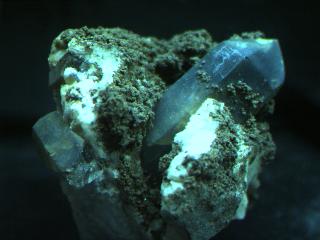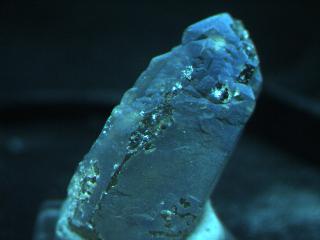
Copyright
Blue Coloured Quartz
from Mont Saint-Hilaire, Québec
By Daniel Comtois
Quartz is a relatively common mineral found in the hornfels or altered pegmatite rock at Mont St-Hilaire, Québec. But the quartz crystals I discovered are extremely unique.
| |

Blue coloured quartz collected from Mont Saint-Hilaire, Québec.
|
It was last fall when I made the discovery. Perhaps I should say, the beginning of winter, because there was already a light carpet of snow on the ground. My friend Sylvain Roy and I decided to try our luck one last time at the Poudrette quarry at Mont Saint-Hilaire. My friend was not yet familiar with the mineralogy of Mont Saint-Hilaire, so I started to explain to him the different areas of the complex quarry, while we were walking and searching for a good spot to dig.
We almost quit our search, because of the cold - it was -10 Celsius at this time of year!) We finished our walk and arrived at an area composed of hornfels. After explaining to my friend that this area could be good for smoky quartz and many micro minerals, I noticed on the rock wall some black and dark brown dust that was colouring the part of the wall located in the contact of hornfels and syenite. I thought it was probably coming from a deteriorated pegmatite with rotten siderite.


Samples of the blue coloured quartz found in the Poudrette Quarry at Mont Saint-Hilaire. The upper photo shows a quartz crystal embedded within matrix. The lower photo is a close-up image of a crystal.
|
I began to look at the wall to see if there was any potential danger (better be safe then sorry). The powder was coming out from behind a huge block of syenite. The two of us worked for an hour trying to remove that heavy piece of rock of about 1 x 2 metres in size, and the most we could do was to move it away about 30 centimetres. There was enough space for me to slide my hand behind. As I slipped my hand under that rock, I just couldn't wait to feel what was behind it. I am sure you know what I mean. In my mind I was already touching giant crystals of a rare mineral that would become the discovery of the year!

Another close-up image of a quartz crystal.
After removing some rocks, I sensed an empty space. So it was a pegmatite filled with crystals of quartz and microcline – well, nothing new under the sun. Moreover, all the specimens were covered with that dark brown mud, which was probably dissoluted siderite – it was ugly to look at. Still, we were quite lucky just to find something at this time of the year, especially when there is no more activity in the quarry. Suddenly a snow storm arrived, so we packed our things, wrapped up the crystals and left the quarry while we could find our way out.


Upper photo showing blue opal covering a microcline crystal. Lower photo showing microcline covered by the same blue opal as the quartz crystals.
|
When I arrived home, I decided to rinse the crystals with water. Most of the mud washed away, but the crystals were still covered with a rust coloured coating. I left everything in a box in the basement. When I had the time, I would buy some oxalic acid powder and remove the rust. A couple weeks later, I finally decided to clean those specimens and see what that coating was all about. First, when clean and wet, the quartz crystals were almost clear, but were not enough dark to say smoky. The crystals were more golden brown. When they dried they had a funny colour - more like a blue tint. When I placed the crystals under a cool white neon light, the colour became a very nice blue.
The coating was very thin, so I had to place the crystals behind the light source to make sure the light did not pass through and interfere with the blue effect. After some research I finally went to see my friend Jerry Vanvelthiusen at the our club in Montreal. He affirmed that the coating it was blue opal, and this affirmation was confirmed by the small spheres of opal on some of the microcline specimens, like the ones seen in the first picture.
Copyright ©1999 Daniel Comtois
E-mail: dancom@simm.qc.ca
Website: www.simm.qc.ca/dancom/
This article may not be copied, distributed or reprinted in any form without the author's permission. To contact the author, please use the e-mail address provided. If you are unable to contact the author, please contact the Canadian Rockhound. Authorized reprints must acknowledge the author, original source and the Canadian Rockhound, and include the website URL address of the Canadian Rockhound.
The preceding article was first published online by Daniel Comtois on his internet website, Daniel Comtois' Québec Minerals. Reprinted in the Canadian Rockhound with permission from the author.
More on Copyright

Document Number: CR993207







